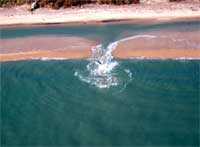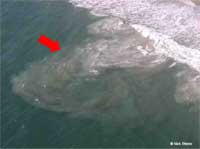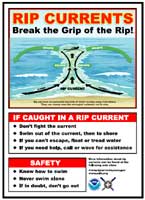|
Rip Tides –
They will get you every time!
You ever hear that old saying, the one that’s a close second to “A Wolf in Sheep’s Clothing”? Yeah, you know it; it’s the one that your grandparents used when they told you scary nighttime stories…
It was the line the adult leader used when telling stories around the campfire…. Yeah, now you remember, “What you don’t know; could kill you”….

Figure 1 (click to enlarge)
|
Rip Tides fall into that category. And I bet you don’t know as much as you should. In fact it’s one of the least understood and most dangerous naturally occurring events known to man.
The Coast Guard and Coast Guard Auxiliary want you to be safe, whether you’re enjoying your day on your boat or playing on or near the water.
The dangers of a rip tide
More people die from Rip Tides than hurricanes and tornadoes. In Florida, 10 people died in 2001, down from 25 in the 90’s. The United States Lifesaving Association estimates that 100 people die each year because of Rip Tides (based on a 10 year average – 1994-2003). This is compared to .6 people from sharks, 18 from hurricanes, 53 from lighting, 58 from tornados and 84 from floods. Heat related deaths top the list at 237.
To add the proverbial insult to injury, the National Weather Service believes deaths from rip tides are under-reported. This makes this naturally occurring phenomenon a very real and scary thought.

Figure 2 (click to enlarge)
|
What is a Rip Tide?
Glad you asked. [see figure 1 and 2]
“Rip tides are strong sea currents which push away from the shore as a strong storm is near. They are formed by the strong winds pushing water towards the shore. Tropical cyclones' winds push waves up against the shoreline even if they are hundreds of miles away, so rip tide warnings are often the first indication of a nearby hurricane.” – University of Illinois
(in fact THIS is a great website which has an excellent animation to show you just how a rip tide is formed).
As the waves move in toward the shore, sandbars begin to build. The rougher surf begins to crash into these bars and flow over them. The large amounts of water, with the tremendous pressure these waves can exert on the sandbar finally punches a whole through the sandbar.
So, just like the old story of the hole in the dyke, water that is sitting behind the sandbar (which is between the sandbar and shore) starts to rush out of our whole in the sandbar. The velocity of the water is much higher than the surrounding ocean.
This movement creates the rip tide, and is the chief reason it is so dangerous.
It is impossible for a human to swim against a rip tide. Think about your chances of running after an automobile that is doing 60MPH. You could keep up. Well you can’t keep up with a rip tide.
But you can out-smart a rip tide.

Figure 3 (click to enlarge)
|
What do do If caught in a rip current
(from the National Weather Service - see figure 3)
- Remain calm to conserve energy and think clearly.
- Never fight against the current.
- Think of it like a treadmill that cannot be turned off, which you need to step to the side of.
- Swim out of the current in a direction following the shoreline. When out of the current, swim at an angle--away from the current--towards shore.
- If you are unable to swim out of the rip current, float or calmly tread water. When out of the current, swim towards shore.
- If you are still unable to reach shore, draw attention to yourself by waving your arm and yelling for help.
Learn more about rip tides
For more information on Rip Tides, see the National Weather Service Rip Current Safety page at https://www.ripcurrents.noaa.gov. The NWS has prepared a brochure on Rip Current Safety available at https://www.ripcurrents.noaa.gov/signs/rip_brochure_final.pdf (please note its a large file).
For more information about the Coast Guard and Coast Guard Auxiliary, contact your local unit or catch us on the web at www.uscg.mil or www.cgaux.org.
|

